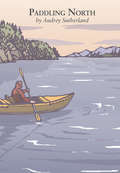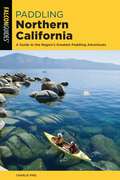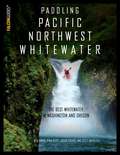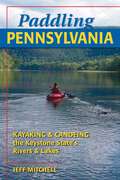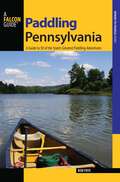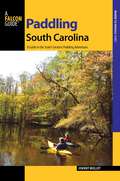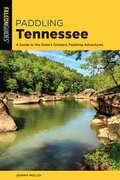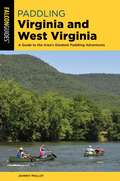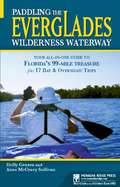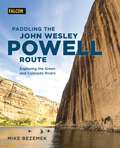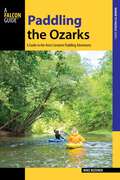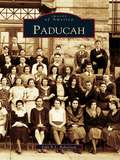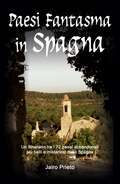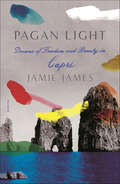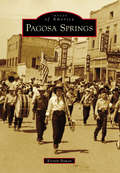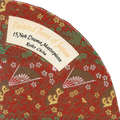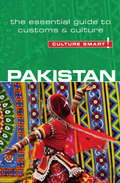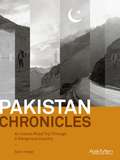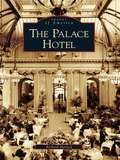- Table View
- List View
Paddling North
by Audrey Sutherland Yoshiko YamamotoIn a tale remarkable for its quiet confidence and acute natural observation, the author of Paddling Hawaii begins with her decision, at age 60, to undertake a solo, summer-long voyage along the southeast coast of Alaska in an inflatable kayak. Paddling North is a compilation of Sutherland's first two (of over 20) such annual trips and her day-by-day travels through the Inside Passage from Ketchikan to Skagway. With illustrations and the author's recipes.
Paddling Northern California: A Guide To The Region's Greatest Paddling Adventures (Paddling Series)
by Charles PikeNorthern California is a paddler's paradise, and this updated and revised guide has all the information you need to plan a variety of excursions. Whether you want to canoe down relaxed rivers or glide across tranquil lakes, squirtboat on frothing whitewater or sea kayak on the Pacific Ocean, this book describes more than 70 paddling trips along 868 miles of California waterways, encompassing 53,400 square miles between Monterey and the Oregon border. Detailed maps include access points and landmarks; flow charts indicate optimum floating seasons; tide information for the ocean trips will help you ride with the current; and full-color photos throughout will inspire you.
Paddling Pacific Northwest Whitewater
by Nick HindsPaddling Pacific Northwest Whitewater is the definitive guide to the best rivers and creeks for kayaking and rafting in Washington and Oregon—home to some of the most fun (and challenging) whitewater in the world. Including over 240 detailed run descriptions from local area paddlers who know these rivers and creeks better than anyone else, this is the only book you&’ll ever need for a lifetime&’s-worth of paddling in the Pacific Northwest. Includes…·Run descriptions·Shuttle directions·Detailed maps·Min. and max. recommended flows·Scouting advice·Awesome photos·And more!
Paddling Pennsylvania
by Jeff MitchellMaps and descriptions for more than 200 Pennsylvania waterways. Information on minimum water levels, potential hazards, and difficulty level of each stream. Includes directions and recommendations for put-in and take-out at each site.
Paddling Pennsylvania: A Guide to 50 of the State's Greatest Paddling Adventures (Paddling Series)
by Bob FryePennsylvania is a paddler&’s heaven and one of America&’s most blessed states when it comes to total miles of rivers and streams. Add in its many lakes, and there is quite simply all kinds and manner of waters where you can set out in a canoe, kayak, or raft. Paddling Pennsylvania describes the best and most accessible routes—fifty classics in all, from Lake Erie&’s Presque Isle lagoons to the Allegheny River, from the Susquehanna to the Delaware. Carefully chosen to be within the ability of most beginning to intermediate paddlers, some routes offer wilderness paddling while others are closer to population centers, but all feature good access points, great scenery, wildlife, and opportunities to have fun.
Paddling South Carolina: A Guide to the State's Greatest Paddling Adventures (Paddling Series)
by Johnny MolloyPaddling South Carolina features 40 paddling adventures, offering destinations across the state. With a focus on recreational paddling, all trips avoid complicated put-ins, portages, and dangerous expert sections but offers concise paddle summaries, excellent route descriptions, GPS coordinates, and sidebars on geology and wildlife. Lakes, rivers, and other bodies of water are featured.
Paddling South Carolina: A Guide to the State's Greatest Paddling Adventures (Paddling Series)
by Johnny MolloyThe hardest part of paddling South Carolina is choosing your route! From the mountain-rimmed waters of Lake Jocassee to the rapids of the Saluda River to rice-field canals along Wadboo Creek, the Palmetto State offers a variety of great paddles all year-round. Paddling South Carolina features 40 paddling adventures throughout the state. With a focus on recreational paddling, all trips avoid complicated put-ins, portages, and dangerous expert sections but offers concise paddle summaries, excellent route descriptions, GPS coordinates, and sidebars on geology and wildlife. Lakes and ponds, rivers and creeks are featured.
Paddling Tennessee: A Guide to the State's Greatest Paddling Adventures (Paddling Series)
by Johnny MolloyThe Ultimate Guide to Tennessee's Great Paddling!Tennessee truly has something for every paddler, whether float trips down dark water trails of swamp rivers or kayaking excursions along whitewater streams. Paddling Tennessee describes the best and most accessible routes, including Reelfoot Lake and the Hatchie River in the west; the Volunteer State&’s contribution to great rivers of the world—the Duck; and the crown jewel of Southern Appalachian paddling destinations—the Hiwassee River. Carefully chosen to suit most beginning to intermediate paddlers, each route provides access to wilderness for city residents and visitors alike.This updated and revised edition features the latest paddling information as well as gorgeous, full-color photography throughout.
Paddling Virginia and West Virginia: A Guide to the Area's Greatest Paddling Adventures
by Johnny MolloyA comprehensive guide to Virginia and West Virginia&’s best paddling trips with routes for every type of paddler, including access points, difficulty ratings, special points of interest, history and more.
Paddling the Everglades Wilderness Waterway
by Anne Mccrary Sullivan Holly GenzenThe Everglades Wilderness Waterway winds an enthralling path through rivers, bays, and streams on the southwestern edge of Everglades National Park. Rich with wildlife and scenic beauty, it also poses many challenges for paddlers. Canoeists and kayakers must deal with wind, waves, limited campsites (in the form of "chickee" platforms over the water and historic groundsites), and no fresh water. As veterans of this complex passage, authors Holly Genzen and Anne Sullivan turn those limitations into glorious, safe adventure. Some out-and-back paddles lead to the rivers and bays of the Everglades National Park's interior; others wind to Gulf Coast sites; still others loop around islands, mangrove forests, or other natural phenomena. The authors provide marker-by-marker route descriptions (both north to south and south to north), and comprehensive information on safety, supplies, campsites, and navigation. They also chronicle the waterway's wildlife, social history, and origin of place names encountered along the way.
Paddling the John Wesley Powell Route: Exploring the Green and Colorado Rivers
by Mike BezemekOn May 24, 1869, John Wesley Powell and nine crewmen in four wooden rowboats set off down the Green River to map the final blank spot on the American map. Three months later, six ragged men in only two boats emerged from the Grand Canyon. And what happened along the rugged 1,000 river miles in between quickly became the stuff of legend. Today, the JWP route offers some of the most adventurous paddling in the United States. Across six southwestern states, paddlers will find a surprising variety of trips. Enjoy flatwater floats through Canyonlands and the Uinta Basin; whitewater kayaking or rafting in Dinosaur National Monument and Cataract Canyon; afternoon paddleboarding on Flaming Gorge Reservoir and Lake Powell; multiday expeditions through Desolation Canyon and the Grand Canyon; and much more, including remarkable hikes and excursions to ancestral ruins, historic sites, museums, and waterfalls. Paddling the John Wesley Powell Route is a narrated guide that combines a multi-chapter retelling of the dramatic 1869 expedition with stunning landscape photography, modern discoveries along the route, overview maps, and information about permits, shuttles, access points, rental equipment, guided trips, and further readings. Come celebrate the dramatic 1869 expedition by exploring the route and learning the story.
Paddling the Ozarks: A Guide to the Area's Greatest Paddling Adventures
by Mike BezemekWith gushing springs, clear-water streams, lush hardwood forests, and limestone bluffs rising hundreds of feet, the Ozarks offer enough paddling to fill a lifetime, including seven streams in the National Wild & Scenic Rivers system and three rivers protected by national parks. Paddling the Ozarks details 40 of the region's best paddling trips—classic floats, hidden gems, scenic lakes, and challenging whitewater. Waterways ranging from southern Missouri to northern Arkansas to Oklahoma&’s Cookson Hills with year-round classics like the Current River, Jacks Fork, NF White, and Eleven Point make this the essential guide to paddling the Ozarks. Paddling the Ozarks reveals that what some call flyover country is better described as paddle-through.Look inside to find:GPS coordinates for every put-in/takeout Detailed river descriptions Maps showing access points and river milesLevel of difficulty, optimal flows, rapids, and other hazards
Paducah: Frontier To The Atomic Age (Images of America)
by John E.L. RobertsonLocated in the westernmost area of Kentucky known as the Jackson Purchase, Paducah has witnessed tremendous change since its beginnings in the early 19th century. Founded by William Clark of the Lewis and Clark expedition, Paducah officially became a town in 1830 and gained the McCracken County seat a year later. Thanks to the area's river resources, the arrival of the New Orleans and Ohio Railroads, and the installment of the telegraph line, Paducah experienced considerable growth, despite the occurrence of natural disasters, before the Civil War when Grant seized the town. Since then, Paducah has become a bustling center of industry, education, and tourism.Images of America: Paducah contains a multitude of photographs that provide a glimpse into the city's period of growth, featuring the contributions of the rivers, the development of accredited Kentucky community colleges, and the unique events, such as the annual quilt show, which attracts 30,000 visitors.
Paducah: Frontier to the Atomic Age
by John E.L. RobertsonOne of the last frontier towns east of the Mississippi, Paducah took center stage in the drama of an expanding United States despite a late start and a penchant for independence and self reliance. The Kentucky river city played no small part in the rise of river commerce and its successor, the railroads. From river packets to enriched uranium, its history is marked by victory over disastrous floods and a headlong rush toward a future embracing new technology.Paducah: Frontier to the Atomic Age tells the story of a community torn apart from the start between Chickasaw and American claims, then Confederate and Union invasions. Exploring the expanding city streets and the ever-busy waterfront, readers will meet natives Quintus Quincy Quigley, chronicler of events on the eve of the Civil War; the "Dean," Dr. Robert Gordon Matheson, who revolutionized two-year colleges; and Mrs. Houston "Dolly" McNutt, among the first female mayors in Kentucky.This unique volume also recounts the story of the city's central role in nineteenth-century history, thanks to its strategic location at the mouth of the Tennessee River on the Ohio. At that time, the Civil War struggle for control of border states tested Paducah's loyalty even while the rest of Kentucky fought to remain neutral, and Reconstruction brought new challenges in race relations to a region deeply divided by the ghosts of slavery. In the twentieth century, the city developed tremendously with the advent of new industry and was the adopted home of President Truman's pioneering Vice President Alben Barkley, among the most effective and groundbreaking statesmen to fill that office.
Paesi Fantasma in Spagna
by Jairo PrietoQuesto libro raccoglie i paesi spopolati più spettacolari e meglio conservati della geografia spagnola, dove potrai scoprire la loro storia e le cause per le quali vennero abbandonati, riconoscere strade, templi, case, cimiteri, piazze, fontane, ecc., e lasciarti meravigliare dalla bellezza dell’ambiente. Inoltre, il libro include oltre 350 fotografie, così come precise indicazioni e coordinate GPS per raggiungere il punto esatto dei diversi paesi. Questo non è solo un libro da leggere, ma ti invita anche a viaggiare, a uscire dalla solita routine e a intraprendere un’appassionante avventura nel cuore e nell’anima di quest’altra Spagna tanto dimenticata quanto misteriosa. Buon viaggio.
Pagan Holiday: On The Trail of Ancient Roman Tourists
by Tony PerrottetThe ancient Romans were responsible for many remarkable achievements--Roman numerals, straight roads--but one of their lesser-known contributions was the creation of the tourist industry. The first people in history to enjoy safe and easy travel, Romans embarked on the original Grand Tour, journeying from the lost city of Troy to the Acropolis, from the Colossus at Rhodes to Egypt, for the obligatory Nile cruise to the very edge of the empire. And, as Tony Perrottet discovers, the popularity of this route has only increased with time.Intrigued by the possibility of re-creating the tour, Perrottet, accompanied by his pregnant girlfriend, sets off to discover life as an ancient Roman. The result is this lively blend of fascinating historical anecdotes and hilarious personal encounters, interspersed with irreverent and often eerily prescient quotes from the ancients--a vivid portrait of the Roman Empire in all its complexity and wonder.From the Trade Paperback edition.
Pagan Light: Dreams of Freedom and Beauty in Capri
by Jamie JamesA New York Times Book Review Editors' Choice"Pagan Light is mesmerizing. Every detail is compelling. I felt I was reading a family history of a family far more interesting than mine." --Edmund White, author of Our Young ManA rich, intimate embrace of Capri, which was a magnet for artistic renegades and a place of erotic refugeIsolated and arrestingly beautiful, the island of Capri has been a refuge for renegade artists and writers fleeing the strictures of conventional society from the time of Augustus, who bought the island in 29 BC after defeating Antony and Cleopatra, to the early twentieth century, when the poet and novelist Jacques d’Adelswärd-Fersen was in exile there after being charged with corrupting minors, to the 1960s, when Truman Capote spent time on the island. We also meet the Marquis de Sade, Goethe, Mark Twain, Oscar Wilde, Compton Mackenzie, Rilke, Lenin, and Gorky, among other astonishingly vivid characters. Grounded in a deep intimacy with Capri and full of captivating anecdotes, Jamie James’s Pagan Light tells how a tiny island served as a wildly permissive haven for people—queer, criminal, sick, marginalized, and simply crazy—who had nowhere else to go.
Pagan Portals - Australian Druidry: Connecting with the Sacred Landscape
by Julie BrettPagan Portals: Australian Druidry works as a supplement to the study of Druidry and other nature-based spiritual paths as practiced in Australia. The seasons, animals, plants and ancestral histories of the land in Australia are quite different from those of the Celtic lands where Druidry originates. Julie Brett discusses the difficulties of following a nature-based tradition in an environment wildly different from Druidism's place of origin, and offers practical information on how to adapt the practice of Druidry to suit the energy of the land and respect its spirits and ancestors.
Pagosa Springs (Images of America)
by Kristin BowenWhen the first government expeditions came through the southwest Colorado region, the Ute Indians were living in a wide area that included the hot springs that they had named Pah-gosa. The Army chose the hot springs as the first--though short-lived--location of Fort Lewis. After the Army left, forward-thinking speculators incorporated the town in 1891. These early settlers believed that the natural wonders nestled in the beauty of the San Juan Mountains could be developed into a world-class spa resort. Timber and ranching were the dominant industries and ways of life in the area throughout the 20th century. The images presented in this book feature these industries, as well as town businesses, churches, schools, surrounding forests, residents, events, and celebrations. Pagosa Springs has become the spa destination early settlers envisioned, yet it holds onto and celebrates its Western heritage.
Painted Fans of Japan
by Reiko ChibaThe chief purpose of this modest little book is to present for Westerners some of the gorgeous paintings found on fans used in tne traditional Japanese Non drama. Painting as limited to conform to the fan shape has teen practiced for hundreds of years in Japan, even hy such immortal artists as Sotatsu and Korin. Until now, however, there has heen no popularly availahle volume of reproductions to reveal the almost limitless possibilities in color, design, and perspective within this restricted form of painting, The artists whose works are reproduced in this book are unknown, and the time when the works were painted can only he estimated as early (1601-1741), middle ( 1742-1791 ) , or late ( 1792-1867 ) Totugawa, the period of Japanese history that extended from the beginning of the seventeenth century to well past the middle of the nineteenth.
Paintings of Portland
by David Little Carl LittleThe city of Portland and its surroundings, including the islands of Casco Bay, have inspired a wide range of art over the past 200 years. The &“city by the sea,&” as Longfellow famously called it, has been a visual talisman for a host of artists, from early masters like Harrison Bird Brown and John Bradley Hudson to a remarkable roster of contemporary painters. Subjects include many of the city&’s signature buildings, including the Custom House and Portland Head Light, as well as street scenes, the waterfront, harbor, back bay, and surrounding landscapes—even the Million Dollar Bridge. Paintings of Portland will feature a wide range of motifs, in all seasons and represented by an array of styles. About a quarter of the book will be devoted to historical pieces, the rest to paintings by contemporary artists.
Pakistan - Culture Smart!
by Safia HaleemPakistan is a land with a unique history, formed by migrating peoples who have left their footprint in its diverse cultures, languages, literature, food, dress, and folklore. The country is besieged by bad news, but despite the political turmoil the everyday life of its people is more stable, rich, and rewarding than the media headlines would lead you to believe. A myriad local festivals and celebrations and a vibrant cultural life go unremarked. Pakistan has the eighth-largest standing army in the world and is the only Muslim-majority nation to possess nuclear weapons, but few know that it is also the home of two unique schools of art. This complex nation consists of various ethnic groups, each with its own individual cultures and subcultures, but which are unified by the common values of hospitality, honor, and respect for elders. Pakistani society has extremes of wealth and poverty, and daily life for most people is full of difficulties, yet everyone knows how to cope with crises. Creative and adaptable, Pakistanis are among the most self-reliant people in the world, bouncing back after major catastrophes. Culture Smart! Pakistan takes you behind the headlines and introduces you to many of the country's little-known traditions. It describes the vitally important cultural and historical background, shows you how modern Pakistanis live today, and offers crucial advice on what to expect and how to behave in different circumstances. This is an extraordinary country of enterprising, tough, and passionate people. Earn their trust and you will be rewarded many times over.
Pakistan Chronicles
by Adam HodgeAgainst the backdrop of fear-mongering media and against the advice of his family, Adam Hodge set out to explore the real Pakistan in a rare road trip through the country that turned into an extended stay. In Pakistan Chronicles, Hodge takes us from Lahore to Islamabad and through the Taliban-controlled northern regions of Pakistan, where few Westerners have dared travel in recent years. What he discovered was a country that defies our expectations and forces us to confront our fears and preconceptions about the unknown. Pakistan Chronicles is a wake-up call to travelers everywhere.
Pakistan: In the Shadow of Jihad and Afghanistan
by Mary Anne WeaverEmphasis on the past fifteen or so years.
Palace Hotel, The
by Richard HarnedWhen it opened in 1875, the Palace Hotel was the largest and most luxurious hotel in the world, a perfect symbol of one of the most remarkable eras in San Francisco history. Built at a time when Nevada's fabulously rich silver mines were pouring millions of dollars each month into San Francisco, it typified the color and grandiose extravagances of the whole bonanza period. After the original hotel was destroyed in the 1906 earthquake and fire, a successor Palace Hotel took its place and remains one of the most prestigious hotels in San Francisco today.
